Hams and HAM Radio
Traditionally, HAM is the informal name for amateur radio operators. The origin of the acronym HAM goes all the way back to 1908, when HAM was the radio station call name (call sign) of the first amateur radio stations from the Harvard Radio Club. Radio amateurs who used the HAM call sign were Albert S. Hyman, Bob Almy, and Poogie Murray. They called their station HYMAN-ALMY-MURRAY, or HAM.
Nowadays the people we call hams are dedicated enthusiasts in radio communications, with an endless passion for electronics, modern digital signal processing, radio propagation, and computing techniques.
In radio clubs and in their homes, hams use different types of radios and antennas on all available radio frequencies to communicate with other HAM radio enthusiasts across the country and around the world. They use HAM radios for establishing contacts with family or friends, for their own personal enjoyment; for emergency communications, and for experimenting with radio equipment. For communication, hams use microphones, telegraph or Morse keys, computers, cameras, and even dedicated satellites like OSCAR.
They develop their own hardware components, usually antennas or amplifiers. Some old-fashioned hams make Morse code machines tailored to their specific needs. Others develop their own software applications and data transmission protocols that are integrated with navigation systems.
Besides the above-mentioned passion and enthusiasm, hams also love to help younger colleagues and to support them in their own efforts to become well-trained radio amateur operators. This tradition has been around for more than 100 years. According to the available statistical information, there are 800K+ licensed radio amateur operators in the U.S.
Related: The Best SHTF Radios
How to Operate a HAM Radio
Before someone starts operating a HAM radio you will need to meet some conditions, such as licensing, knowledge of the equipment that’s used for amateur radio communication, QSO contact establishing, and QSL cards exchange.
At the beginning, it is very important to get familiar with specific terminology and the protocols and procedures for communication in the hams’ world. This is something that can be done quite easily. For example, even eight-year-old children have gotten licensed – or “got their ticket,” in HAM language. There are several types of licenses which each grant different privileges and responsibilities, such as Technician, General, Amateur Extra and so on. The starting point for a ham career is to get a Technician-class license. When joining an amateur radio club or buying your own radio equipment, this license allows you to talk to people at long distances using less than 100 watts of radio power. Other types of licenses, like General and Extra, offer some additional frequency bands (HF frequency bands) for radio communication at very long distances and using more power. U.S. amateur radio frequency bands and short comments about the frequency allocation models are presented in Picture 1.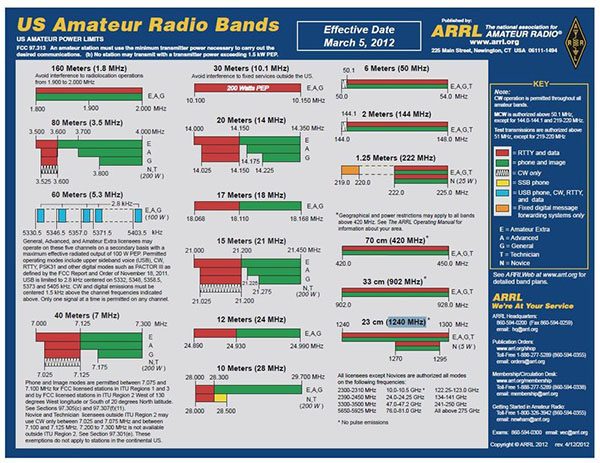
If you want to use available ham resources like repeaters, it is also important to be aware of repeater channel spacing and offsets. Some radios are pre-programmed to repeater channel frequencies, and some will need to be programmed. Table 1 presents a list of repeater channel spacing and offsets.

After they get their ticket, they will have to know some basic things about radio equipment that they either already have or plan to use at an amateur radio club. It is necessary to know details about the following:
- Radio transceiver – This includes frequency range, power, manipulation (changing the power, channels/frequencies, tuning the radio, connecting the antenna and power supply, microphone, Morse key, additional cables or loudspeakers, etc.).
- Power supply – This has to be compatible with the transceiver. It has to provide the needed voltage for proper functionality of the transceiver. If the voltage is too low, the transceiver will not be capable of turning on. On the other hand, if the voltage is too high, it can burn out the transceiver.
- Antenna and antenna tuning unit – If needed, these have to be compatible with the transceiver’s frequency range and power. There are different types of antennas, and it is important that their usage does not cause any legal issues (in terms of power, size, where they are mounted, etc.).
- Microphone or key – Depending on the mode, a microphone can be used to send voice or a key can be used for Morse code sending.
Now it is time for QSO. The radio has to be turned on, and a clear frequency must be found. It is always polite to check again to see if the frequency is being used by someone. If it is clear, the recommended time to check if someone is present and waiting is three to four minutes before changing the frequency. Sooner or later someone will answer, and then information can be exchanged according to protocol. After introductions, communication usually proceeds with the exchange of data about radios, power and antennas on both sides, age, precise locations, weather, amateur radio experience, etc. Hams use Q-code for this communication on every mode and even in face-to-face conversation. Each Q signal is represented by a three-letter question or answer. A complete list of ham radio Q signals, including those used on nets and repeaters, is presented in Table 2.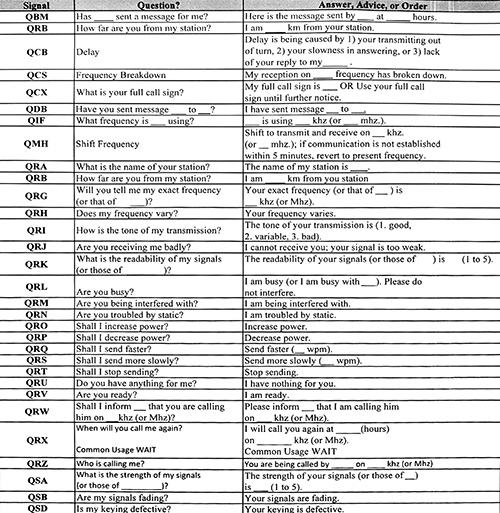
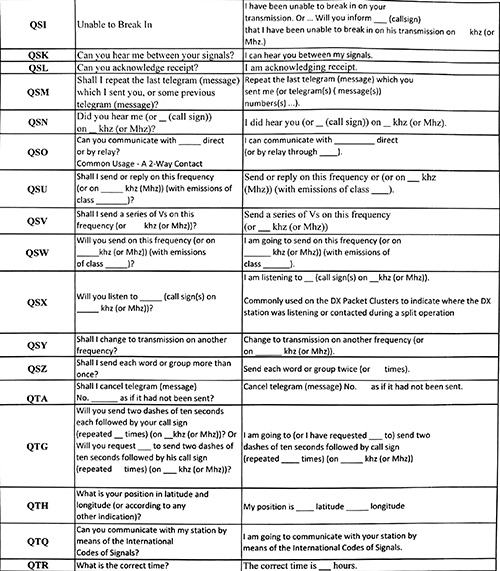
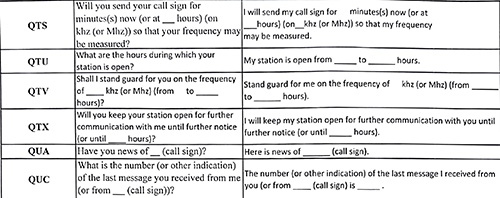
Related: SHTF Survivalist Radio Lists
Besides the official Q-code, there are also some internationally adopted acronyms that are very useful for conversation between hams:
- 73 – Goodbye
- 88 – With Love
- SK – Signed off (last thing you send)
- GL – Good Luck
- CU – See you
- AGN – Again
- HPE – Hope
- GM – Good Morning
- GA – Good Afternoon
- GD – Good Day
- PSE – Please
- HNY – Happy New Year
- UR – Your or You’re
- FB – Fine Business
- OM – Old Man
- YL – Young Lady or any woman who is unmarried
- XYL – Wife
After contact is over, it is common practice to exchange QSL cards between hams involved in communication. They can be sent using online logging websites or by mail. Many hams enjoy collecting them.
Benefits of HAM Radio
Although the ham community in the U.S. is very representative and gathers people from different professions, HAM radio is also the first choice for preppers. Preppers need radio that:
- Can provide a long range in different surroundings (urban, rural, woods, deserts, tropical forests, etc.), according to modular power, allocated frequency ranges, etc.
- Is capable of receiving emergency radio broadcasts.
- Can support communication with emergency services.
- Is able to fit emergency needs.
- Is suitable for maintenance.
The general conclusion is that HAM radio fulfills all the mentioned criteria. A very important fact is that HAM radios are extraordinary and robust communications devices that work in all kinds of emergency conditions.
Related: How To Make A Tin Can Directional WiFi Antenna to Extend your Communication after an EMP
In typical emergency scenarios like hurricanes, earthquakes, or other public emergencies, HAM radio is on the front lines supporting organizations like the Radio Amateur Civil Emergency Service (RACES).
In these situations, HAM radio clubs activate their local HAM nets to track severe weather and provide all kinds of useful information.
For example, preppers and public emergency services used HAM radios when there was an earthquake in Seattle in February 2001. It was possible to know where all the disruptions to traffic flow were. It was also possible to contact hams and receive useful information over HAM radios while all phones, including cellular lines, were down.
After the devastating hurricanes in 2017, especially when Hurricane Maria knocked out Puerto Rico’s communications, HAM radio operators established crucial contacts with rescue agencies.
It is very easy to imagine various scenarios where communication could make the difference between life and death at an individual level.
The ability of preppers to be ready for HAM radio information exchange when receiving a call from an emergency communications group is very important. It is useful to have prepared personal equipment like the following:
- Dual-band (VHF/UHF) handheld radio and mini manual
- Full-size flexible whip antenna
- Copy of your Federal Communications Commission (FCC) license and any EmComm IDs
- Mag-mount antenna with necessary adapters for connecting to various connectors
- Extra battery packs and charger
- AA-cell battery pack if available and fresh batteries
- AC power supply and cigarette-plug cord with spare fuses
- Headset with microphone (preferred) or speaker mic
- Copy of your local EmComm frequencies, phone numbers, and procedures
- Pocket knife and/or multipurpose tool
- Flashlight or headlamp and spare batteries
- Pencil and notebook, clipboard, and permanent marker
- Duct tape, electrical tape, and a few small cable ties
- Cash for food, gas, and telephone calls (about $20 in small bills and change)
For newcomers and hams that want to refresh their knowledge, there are some very interesting websites that can provide necessary information: ARRL, AC6V, QRZ.com, eHam.net, DXMAPS.com, DX Summit, TAPR , WA7BNM Contest Calendar,
We must be aware that HAM radio is the optimal solution for a diverse range of use cases. It is a way for meeting new friends, it feeds explorers’ imaginations, it very often provides the one and only way to contact people in emergency scenarios, etc.
Finally, somebody’s next HAM radio contact may be someone like Carlos, King of Spain – EA0JC; Les Hamilton (He first alerted Britain of Argentina’s invasion of the Falklands in 1982.) – GM3ITN; Bhumiphol Adulayadej, King of Thailand – HS1A; Francego Cossiga, the former Italian President – I0FCG; Akio Morita, the founder of Sony – JP1DPJ; Masaru Ibuka – Co-founder of Sony- J3BB; Patty Loveless, country music singer – KD4WUJ; Stuart Alden Cook (Stu Cook), bass guitar player in American rock band Creedence Clearwater Revival – N6FUP; and many others.
The idea of establishing contact with some of them is at least worth a try.
You may also like:
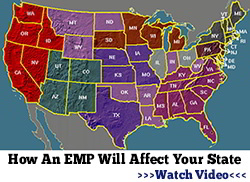 Nuclear Protection Supplies You Need To Have Ready
Nuclear Protection Supplies You Need To Have Ready
US Nuclear Target Map. Do You Live in The Danger Zone? (video)
How To Tell When People Are Lying to You (in a crisis)
23 Motives to Prep Even If Doomsday Never Arrives
US Official Procedures Before SHTF. How to Know Before It Hits

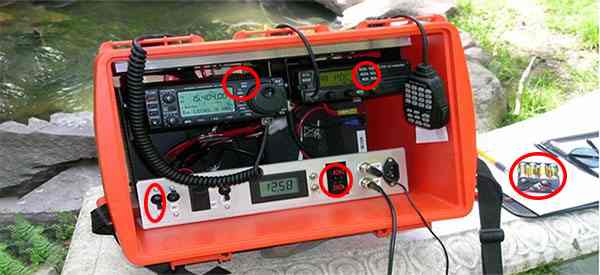













Please, it is lower case ham, never HAM, not H.A.M. or any other variation. Just ham.
Very good article; If you want to sit in you shelter wonder what’s going on and having no resources of obtaining information (The great anxiety). . .then don’t get a radio.
Here are some thoughts: Testing for a license is so much easier then it was in the past and cheap. Also no Morse code requirement anymore, even though I encourage if you can learn it as you can talk farther with it.
Radio can be and is also fun with many other activities more then you may be aware. Our youngest Ham operator was 8 years old.
Also Ham radio is for everyone, I have great hearing loss but I have transmitted via blue tooth through my hearing aids.
Why get a license? I have been doing Ham Radio Since 2000. I have learned if you do not use the radio often, it may not work when you need it or in that need you have a hard time figuring it out.. Radios nowadays are more user friendly. But batteries go dead, channels are not set or antennas are wrong or many many reasons. I have seen it so many times.
I agree with the article, have one even if you don’t want a license. But break it out and listen, or have someone with a license come over and with them present you can use their License number. This will give you confidence in the radio and diminish the first anxiety of radio . . . .Does my radio work?
Also EMP protect at least one radio. Antennas attached can provide a path for EMP energy. I also think it is prudent to invest in one good radio even if you have the cheaper portables.
If you have a antenna for your shelter fixed outside, learn lightning precautions, disconnect antenna during the storms and remove your mike as a personal reminder that the antennas detached. (Don’t want to burn up your radio by transmitting without the antenna.)
Also do not store radios with batteries connected……..
Over the years we have already saved lives and prevented loss of life during high sport activities which we assisted with. We have also provided safe travel for those with radios traveling on roads hampered by winter storms.
They are cheap now, so I can’t think of any reason for not having Ham Radios in your kit.
I hope this is helpful. 73’s AF1SG
I totally agree about learning Morse. Other advantages are that a Morse key is more robust than a microphone and will keep you transmitting longer when things start to fail, and that Morse is a layer of simple security. It won’t do anything against a skilled attacker, but how many looters with a handheld pillaged from Radio Shack are going to be able to understand Morse?
FB OM. Great article Mike…. Being a really OLD ham for some 70 + years good summary. A Keeper W7MRT
Another good source of info for Preppers is the AMRRON website. American Redoubt Radio Operators Network.
As a ham since the mid 1980s, I can honestly say that there is no more fun and interesting hobby and public service than ham radio. I would suggest that if you are interested in joining the ham radio community, check out the ARRL website at www,arrl.org (Amateur Radio Relay League). The ARRL is the organization that supports ham radio in the USA. There are many different facets of ham radio including voice, digital, television and satellite communications, to name a few. There is something for everyone!
Back when I was K4JHM and a member of the Alexandria (VA) Radio Club, we had a 7 year old member who had a faster ‘fist’ than me – and I was comfortable at 40WPM (former Navy Radioman (RM1). I can QSO for hours about stuff from those days, but would like to comment here that by far and away, the best approach to learning about Ham Radio (note the upper case “H”) and obtain current material to study and pass one of the many Amateur Radio license tests. The other, nearly as important approach, is to also join the nearest Ham Radio club. Find just one “Ham” to begin with by Googling for licensed Hams in your neck of the woods. You will be surprised at home many are nearby. Any old-timer will be happy to guide you.
K3RMV
Oops! I left off mention of the ARRL (www.arrl.com) as one of the two MUST approaches to becoming a licensed ‘Ham’. My 80-year-old brain hiccups, from time-to-time.
73
K3RMV
a
Hi frequency transmissions are also another way of communicating over long distances. There is no repeater needed, just a lot transmission power. World wide contacts can be made by voice or code. Then there is echo link over the net even through your cell phone to link up with world wide repeater links.
When Gary says “a lot of transmission power”, you should understand that most hams use no more than 200W, though we can legally go up to 1500W. Propagation conditions are more important than power, though. When conditions are good, 10W is plenty.
aL (K3RMV) again. Gary is right on. I might add that you can get anything to radiate a signal – even a lightbulb. Example: I was repairing a LINK 6M transmitter for our club’s 7 year old Ham. At my little desk in the corner of my bedroom in the Alexandria, VA, area, I was using a 60 watt light bulb as a ‘dummy load’ antenna, when a signal from way across Washington (DC) came in. A fellow Ham had been listening to me, testing on the microphone. A brilliant idea struck, and so I soldered the light bulb onto the end of around 50′ of COAX, which I stuck on the roof of the little house I was renting. Then, at night, I commenced to have some QSO’s with area Hams spread all over DC, Alexandria, and Bethesda. The light bulb was my antenna, and blinked with various levels of brightness as I spoke into my microphone. Had my neighbors scratching their heads, for sure. Point is, ANYTHING will radiate a signal, if you go about adjusting your transmitter properly.
Let me add one more comment. In the old days, when I was a very poor Ham and needed parts (wse built everything ourselves), I was always able to get parts from old TV’s, radios, and the like. I built my very first ‘rig’ using such parts, plus one of my wife’s bread pans, an old 5-tube radio, and $2 surplus earphones. Oh, yeah, I also ‘bought’ a good telegraph key. A microphone was easy to make, so I was in business. Point here is that, given sufficient imagination, anything is possible – like building a ‘Foxhole Radio’ using a razor blade, pencel, junk wire, and earphones. WW-II troops often built such radios in their ‘foxholes’. Perhaps someone here has a better Foxhold Radio history and comment
Challenge yourself, and anything is possible.
73,
Al, K3RMV
I never had a foxhole radio but at NAS Iwakuni the base exchange sold crystal radios that needed no electricity or batteries. They were set for the AFN radio station and I could listen via earplug to AFN without disturbing anyone else.
I gather from your comments that any wire will work as an antenna it doesn’t matter if is is twisted or solid. Is that a correct inference?
Al, it sounds like you have a tremendous amount of knowledge about the building and workings of radio equipment. I have been a ham about 5 years and would love to learn how to build radio equipment. Is is even possible today? Just wondering if one can still find the needed parts? I would love to pick your brain sir. Thanks for your contribution to our wonderful hobby.
If you want to build ham radio equipment, get any copy of the ARRL Handbook from the last 30 years for plans, tools, and techniques, and use Google to find parts suppliers. Jameco, Digikey, Mouser come to mind. (Digikey was founded to sell a digital CW keyer to hams, by the way. The product didn’t sell, but selling off the parts got them going!)
I’m curious. As an Amateur Extra and a 20+ year ham, I never heard of ‘and so on’ license. I’ve helped on a test session for Emergency Communicator, a certificate I don’t personally have, although I’ve worked several active emergencies and a bunch of drills, and know I’ve helped to save at least one life.
Get that ticket! (license) not only is it useful, it’s a lot of fun! Check out hamstudy.Org for a great study aid in flash card format.
73 de ki7onn
While this is a well-written article with lots of general information about ham radio, it doesn’t live up to its title. It doesn’t give instruction on how to use a radio. That’s what my prepper friends and I need. We have the radios but can’t figure out how to actually talk to anyone.
Jan:
You may want to find a local ham radio operator and incorporate them into your group. They will have the equipment, and will be able to do the education you are looking for.
What radios do you have? It would be best if you could find an experienced ham operator to show you how to make contacts and which frequencies are best for the time of day/night. Also, don’t worry so much about power output; the antenna is what counts, and can be nothing more than a simple wire and “antenna tuner”. My HF radio, as many others these days, has the antenna tuner built into the radio! Things have gotten easier. I have the radios, but we are flood victims, and with my former career, I have not been on the air for a few decades. Still trying to get an antenna set up, if we ever stop having to move! KB5AVP (you can look me up on the ARRL website without having to join; just look up anybody by call sign, and probably location and other criteria (I don’t remember; it’s been awhile).
No excuse not to get a license.
My daughter got her license when she was 8 years old.
$200 can get you a used HF transceiver. Also, makes a great general purpose receiver.
Jan, what you need to do is get a license and join your local radio club. I run license study sessions for two clubs, and I know other clubs do likewise. Tell the members you’re a newbie and they’ll step up to help you. Every ham I know wants to help newbies. As AK4BL says, radio gear isn’t expensive. You can get a new dual-band handheld for under $50.
Jan,
In the process of getting any one of several FCC licenses in the Amateur Radio hobby field, you will learn how to tune and operate receivers and transmitters.
To do otherwise and tinker with your radios can result in illegal signals, interference with licensed signals, and even loss of life, landing you before a judge.
Bill (KC6GCR) is right on the mark.
I have been a licensed ‘Ham’ for over 60 years. Back then, study material was difficult, and we had to become proficient with Morse Code at a minimum of 5 words per minute.
Through the efforts of the American Radio Relay League (ARRL) and others, the FCC made it much easier for entry level Ham Radio licensing.
Find and join the nearest Amateur Radio Club, and also contact one or more ‘Hams’ nearest you. And don’t forget to visit the ARRL at http://www.arrl.com where you will find study guides for all levels of licensing.
Once a ‘Ham’, always a ‘Ham’. You will be amazed at how many famous people can be found on the Ham bands, like the King of Jordan who was an avid Ham.
Alex K3RMV
I agree with Jan, the article does not do as advertised. It would be helpful if the person writing the article actually gave us some useful information.
By the way, what does CQ mean in the ham world?
CQ is basically ‘Anybody out there who wants to talk (or transmit in some other mode) please respond.’ It can also specify a geographic area. You can say the letters or ‘Seek you’ as a way to give exactly the same message.
where do i acquire equipment?
What you want to do determines what you want to get. And that determines where you need to get it.
So, first decide what you want from your equipment.
Do you want to talk 5-15 miles clearly? Do you want to communicate using your computer or microphone over 1,000 miles? Keep in mind that Ham radio is not a cell phone. It is in many instances better and in some cases worse.
yes im cb / ham operator have a cobra mobile radio as a basestation it has cw / fm / am / usb / lsb / cw. my ant is a-99 solarcon antenna ham / cb antenna.
CB is NOT a ham operator, Sorry.
Here’s the “quick and easy cheat sheet”.
1. Check connections between power, radio, microphone, and antenna.
2. Apply power.
3. Select operating frequency, as agreed with the other ham with which you intend to communicate.
4. (Adjust antenna tuner as needed.)
5. Listen for ongoing traffic on the frequency.
6. At the scheduled time, squeeze the mic and say “[call-sign of called station], [call-sign of called station], this is [call-sign of calling station]. Pause.
Repeat if necessary.
7. Called station responds: “[call-sign of calling station] this is [call-sign of called station]. Go ahead.”
8. Then you have your conversation.
9. When done, each says “this is , out.”
10. Turn off power.
11. Disconnect antenna (to prevent lightning damage).
The frequency is then free for anyone else to use.
Your call-sign was assigned to you when you got your license, and it can encode some basic facts about when and where you got your license. If you don’t have one, no licensed hams will talk to you, because you’re not a ham, and hams are only licensed to talk to other hams. If you try to spoof a call-sign, it might not encode the right info, or may duplicate someone else’s, and they’ll know that you’re a fraud.
A little piece of my text in #9, above, got dropped. It was supposed to say: …each says “this is [your call sign], out.”
Hams often say, to be polite, “73” somewhere at the wrap-up. It comes from the musicality of the corresponding morse code: da-da-dididi dididi-da-da”.
Three other supposed origins for the term “ham”. Early amateurs imitated broadcast stations, and were dismissed as “hamming it up” on the air. Amateur radio-telegraph operators did not operate their keys well, and were described as “ham-fisted”. In some English dialects, the initial “h” sound is optional (as in herb vs. ‘erb), so some put an audible “h” before ‘amateur, shortened to ‘ham”. Whatever. ARRL doesn’t capitalize it: “ham”, not “Ham”, or “HAM”, is the current style.
I want to learn how to use a ham system but all I can find are references to the frequencies, codes, etc. nothing tells me how it functions, how it’s s used, what protocols to use, customs and courtesy’s, and actual working of the syste,. Suggestions? I’ve viewed loads of YouTube videos and I’ve learned nothing. Obviously I am looking at the wrong ones.
Answers to your questions about the “protocol stack(s)” for ham radio are too many and varied to be completely provided in a blog comment. See ARRL.ORG for more info. You can also look for a used copy of the “ARRL Handbook for Radio Communications” (the title varies over the years) if you don’t want to spend $50 on the current version.
The short answer is: “the FCC (in the US) defines boundaries of the PHY layer”, the rest is products, habits, and customs, some of which are very local and/or specialized.”
Your reference to “the system” may reflect a misconception, if you expect to find a unified, organized system to access. Ham radio is a sandbox in which different people play different games, and you’re free to make up your own game if you can get someone to play with you. (But, remember to stay in the sandbox.)
Licensing has always been the downside to ham radio. CB fills the gap with line of sight +- capability that covers local areas. No licensing, many channels and easy availability make a great place to start. And Big Brother is not involved.
OK: I’ve read a lot about Ham (ham, HAM) radios being the only viable source of communication after any SHTF scenario. I’m a believer.
I’m also a 70 Y.O. woman without any knowledge of electrics or such things. I WOULD begin with the license, but am wondering, EXACTLY what would I need to communicate with family over 900 miles away? is it even possible? (I’m assuming yes, since I’ve heard that sometimes communicating over other continents is possible).
I’d like to begin getting what I need before prices go any higher, so I need to know what exactly to get for my needs later.
Thank you for anything you can tell me.